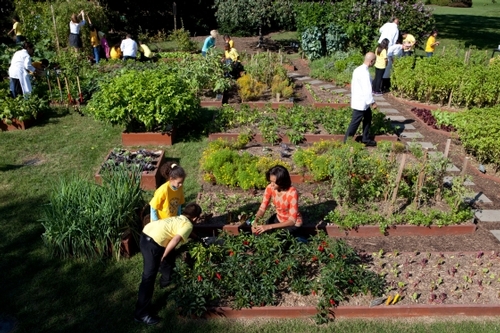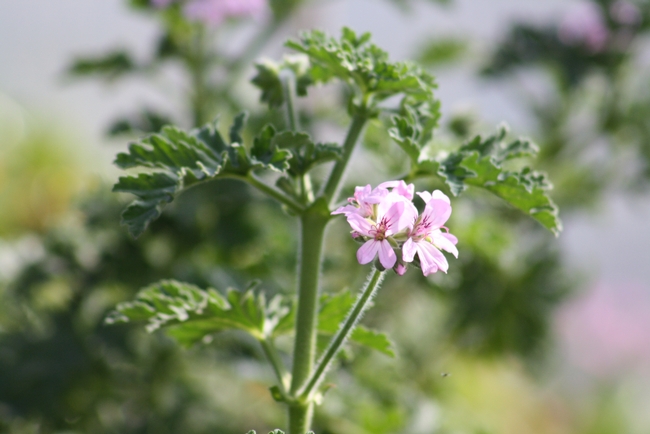UC Blogs
What Do You Want for Your Birthday?
Several women I know asked for jewelry, cruises or trips to Las Vegas; but I asked for raised beds. Walking around the backyard I picked out a good spot -- taking in consideration the hours of sunlight -- my husband and I visited the various box stores in the area. Redwood was chosen because of its ability to last longer. Our measurements were six feet long, four feet wide and 22 inches high. The height was important to both of us because we are in our seventies and don't bend and stretch as easily as we used to.
We lined the box sides using staples to keep the soil from leaking out between the planks. After doing the math we ordered three yards of special soil mixed especially for raised beds. In addition, I incorporated four bags of dried chicken manure from a local organic chicken farm.
We enjoyed a bounty of vegetables, greens and herbs and I was amazed at how well plants grew in a raised bed. I found it very interesting that beneficial insects easily found the plants growing in a high rise environment, but the troublesome pests appear to have a more difficult time finding the plants. Very few problems.
The first raised bed we built provided us with strawberries throughout the season. I am still able to go out in the morning every couple of days and find a few small and delicious berries. I am now thinking of changing bed # 1 as a herb garden instead of having the herbs spread all over the yard.
How lucky I am to have a husband who indulges my 'crazy birthday ideas' -- that end up benefiting the both of us!

The beginning of the raised bed. (photos by Danielle Wilkowski)

Vegetables spilling out of the raised bed.

Yum! Strawberries!
Exotic pitahaya possible desert cash crop
A native of Mexico and South American, the beautiful tropical fruit pitahaya - also known as dragon fruit - could be a viable crop for Southern California desert, said an article in the Desert Sun.
Ramiro Lobo, UC Cooperative Extension advisor in San Diego County, shared the results of pitahaya studies conducted in San Diego and Irvine with a group of inland desert farmers recently.
“The fruit size and quality is good ... we’re getting great marketable yields,” Lobo said.
In March, five varieties of the fruit were test-planted at UC Riverside's Coachella Valley Agricultural Research Station in Oasis.
“We’re selecting varieties that can tolerate the heat,” said José Luis Aguiar, UCCE advisor in Riverside County. “They’re doing well in San Diego County and Irvine and we’re trying to extend the range.”
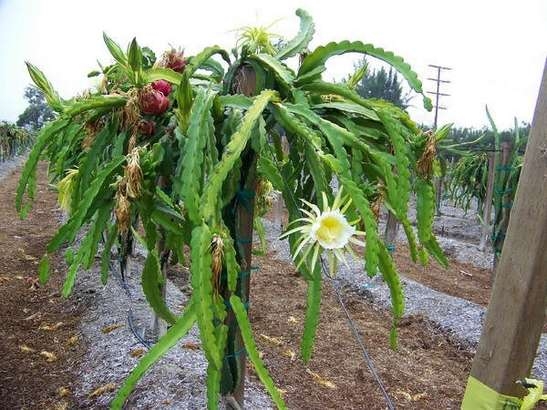
Dragon fruit grows on a cactus plant. (Photo: Jose Luis Aguiar)
Well, Hello There!
At first they appeared on our pomegranate tree, our 85-year-old pomegranate tree. Then they migrated over to our passion flower vine, Passiflora,...
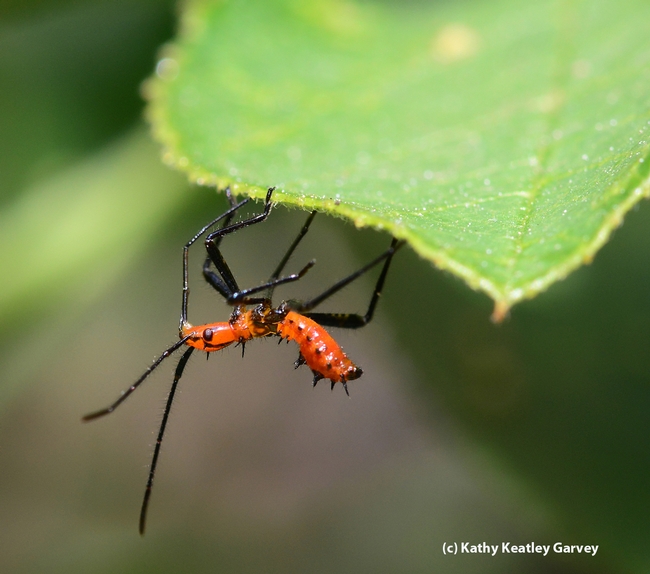
Leaffooted bug nymphs, Leptoglossus clypealis. (Photo by Kathy Keatley Garvey)

Leaffooted bug nymphs, Leptoglossus clypealis. crowd a leaf of a passion flower vine. Note the yellow Gulf Fritillary eggs on the leaf. (Photo by Kathy Keatley Garvey)
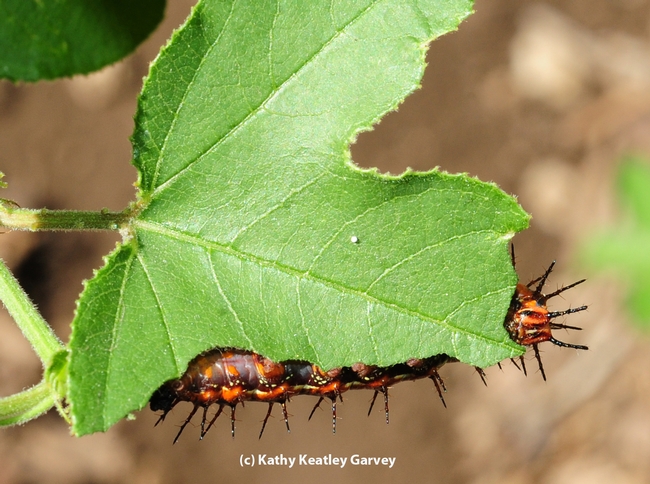
Close-up of a Gulf Fritillary caterpillar. These leaffooted bug nymphs are sharing leaves of the Passiflora with Gulf Fritillary caterpillars. (Photo by Kathy Keatley Garvey)
UC Cooperative Extension Leader to 'Tweet' from White House Garden on Friday
Above Photo: Michelle Obama works in the White House Kitchen Garden (White House photo.)
California will be well represented on Friday, Oct. 19, when Michelle Obama's kitchen garden-a model vegetable garden on the south lawn of the White House-is the site of a national "Tweetup." Rose Hayden-Smith, UC Agriculture and Natural Resources sustainable food systems initiative leader, will be part of the White House Social Fall Garden Tour.
Follow the event in real time from 5 a.m. to 12 noon Pacific Time on Twitter using the tag #whgarden.
White House Social is a series of in-person meetings of people who engage with the White House through social media, including Twitter, Facebook and Google+. Hayden-Smith has followed Barack Obama, Michelle Obama and the White House on Twitter since Obama's election in 2008. She won the invitation after entering a contest that asked contestants to describe in 140 characters why they wanted to visit the White House garden.
"I'm really excited to be part of this," said Hayden-Smith, who is also a UC Cooperative Extension advisor in Ventura County, specializing in 4-H youth, family and community development. "The fact that the Obamas are cultivating a food-producing garden on the grounds of the White House says really wonderful things about our country. The First Family is showing its concern about the health of Americans and reducing childhood obesity. That's something we at UC Cooperative Extension care a great deal about."
Hayden-Smith Tweets as "Victory Grower" (@victorygrower), a persona she created to reflect her interest in a national revival of the Victory Garden movement, in which increasing food production was considered vital to bolstering national security by creating a more secure food supply.
"It's a different 'victory' now, but many of the goals are the same," Hayden-Smith said. "Gardens connect people with food and food production. Food is fundamental. It's what everyone shares in common. As we are entering a more challenging era of increased population and pressure on resources, it is vital for people to understand how to cultivate food."
Hayden-Smith travels to Washington D.C. on Wednesday, Oct. 17. On Thursday, she and her colleague Rachel Surls (@rachelsurls), UC Cooperative Extension advisor in Los Angeles County, will tour urban garden projects in the nation's capital. They will be Tweeting about their tour on Thursday afternoon using the tag #urbanag.
Though not an official part of White House Social, Surls will have a brief tour of the White House Kitchen Garden on Friday. She will Tweet on Friday using the tag #whgarden.
Surls and Hayden-Smith are joining wtih UC Agriculture and Natural Resources to promote urban agriculture in California, an effort that is expected to generate multiple benefits. Gardening provides a way for people to be physically active, to improve food access, to increase fruit and vegetable consumption and to reconnect people with agriculture.
Scented Geranium
Pelargonium, although commonly referred to as geraniums, or scented geraniums are aptly described as living potpourri for the home. They are not grown for their flowers so much as they are for their scent. Most are native to South Africa and became popular with Victorians when the colonists brought them back to Britain with them. Unlike other garden plants that are fragrant only when blooming, scented geraniums are fragrant all year long if not dormant. The scent is contained in small beads of oil produced in the glands at the base of the leaf hairs. Bruising or crushing the leaves breaks the beads and thus the plant releases its scent. All are wonderfully fragrant and have a distinctive smell, but I’ll leave it to your nose to pick your favorite.
Harvest and Use: Scented geraniums are a lovely addition to fresh cut bouquets. Their long stems of foliage will keep for 2 to 3 weeks. During Victorian times this foliage was a favorite in tussie-mussies, which are traditional, small bouquets from fresh cut flowers because of their fragrance. Historically, they have been used in the perfume industry, especially the rose-scented one as they are much less costly.
NOTE: The Master Gardeners do not recommend using any plant in cooking if it has not been properly identified.
Scented geraniums, like culinary herbs, have a place in the kitchen. Layer leaves in sugar to flavor. Line the bottom of a cake pan with leaves before pouring in the batter. Dunk bunches in apple jelly before removing from the heat. The leaves can be added to fruit punches, vinegars, salads, and marinades. They combine well with lemon verbena, lemon basil, lemon balm, and mints. Try steeping rose scented, lemon, or ginger leaves in black tea for a treat. Add cloves and slices of lemon and orange to hot or iced tea. Freeze in ice cubes to add to cold drinks later. The flowers can be few but also add a lovely touch when used to embellish something created with scented geranium leaves.
Cultivation: Scented geraniums are not difficult to grow. By following a few easy tips, they will flourish. They grow best in temperatures that range from 50 to 60 degrees at night and 65 to 75 degrees during the day. In frost-free areas they can be grown outdoors all year. They like a fast-draining soil and full sun. When grown in a pot, use a soil-less mix of half peat moss and half perlite or a “potting soil”. Garden soils tend to pack down and drain too slowly, depriving the roots of oxygen. They like a slightly acid soil close to a pH of 6.5.
They do well in dry areas where other plants might have difficulty surviving. Pathways edged with scented geraniums give off their fragrance when passerbys brush against them. Their varied leaf shapes, texture, color, and variegation make them ideal for a window box. Try combining them with nasturtiums, pink or purple petunias, trailing verbenas, and ground ivy. Don't crowd the plants as they like good air circulation. In frost areas, they can be grown as annuals or brought in during winter. They do well on a windowsill. Do not bring them in after the night temperature drops below 45°F, as they will be shocked by the warmth, causing leaves to yellow and drop. Scented geraniums need only four hours of sunlight. In lieu of this, fluorescent lights mounted a few inches from their tops will provide enough light. Repot your scented geraniums every 2 years.
Scented geraniums are a bit fussy about over watering, which, like for most plants promotes soil-borne diseases/pests and soft weak plant growth. Water only when the top of the soil feels dry. Water until it runs out the drainage holes. This not only wets the soil, but flushes out salts left from fertilizers. Never let the pot sit in a saucer of water for any longer than 10 minutes, and keep water off foliage and flowers to prevent the spread of diseases. Watering in the morning on a sunny day keeps leaves from being wet all night.
Scented geraniums like a lot of fertilizer such as magnesium. A teaspoon of Epsom salts will provide enough magnesium for good growth. During the growing season from April to October, fertilize with 15-15-15 or 15-30-15 mix, applying half the recommended amount every second watering. Except for the few that are compact, scented geraniums need to be pinched and pruned for a full shape, otherwise, they become leggy. Snipping off the tip of a growing stem will force it to grow at the nodes. Pruning should begin once the plant is 4-5 nodes or 6" tall. Snip off the tip with sharp scissors or a razor blade. Shoots will grow within 2 to 3 weeks. Once the plant is shaped to your liking, allow it to bloom. This will take 6 to 8 weeks. Thereafter continue removing browned leaves, excessive growth, and spent flowers. If you wish to propagate new plants, allow the plant to grow beyond where you regularly trim. New growth should be 4 to 5 nodes in length. The best time of the year to prune is late winter/early spring.
Propagation: Most scented geraniums are hybrids, therefore few can be grown from seed. Species to grow from seed are: coconut, apple, lemon, old-fashioned rose, and peppermint. The best way to propagate hybrids is from stem cuttings. It takes about 6 weeks for roots to form.
1. Fill a 2 ½-inch pot with soil-less mix for each cutting that you plan to take. Very lightly settle the mix with your fingers and then water the pot until the excess trickles out the drainage holes. The soil should now be ½ inch below the rim of the pot.
2. Select a healthy, established stock plant from which to take the cuttings.
3. Select actively growing shoots that are firm, not floppy. You can take cuttings throughout the growing season, but success is more certain in spring and fall. Don't use the older, woody (brown) portions of the stem. Each cutting should include at least three stem nodes, but four or five are better. A node is the point on the stem at which the leaves are attached.
4. With a single-edged razor blade (especially good for thick stems) or very sharp, scissor-type gardening shears, make your cut just above a node on the stock plant. If the stems are long enough and you need more propagating material, you can also take cuttings below the tip. Don't leave a stub: it can become a target for disease.
5. Re-cut the stem to just below its lowest node. This is the spot where root formation is best.
6. Remove the leaves from the stem that will be under or close to the soil surface. Dip stem including area where leaves were removed in rooting hormone and tap off excess. It is best to bury at least two or three nodes. Also remove any stipules that are found at the base of the leaf stems, since these can rot if buried.
7. With a sharpened pencil, make a hole in the center of the soil-less mix deep enough to bury the lower nodes and insert the cutting. Settle the soil around the cutting by gently re-watering the pot.
8. Place the potted cuttings in a spot out of the wind and direct sun. If the weather is cool, place them on a heating mat. Rooting is quickest and most successful when the soil temperature is 70 to 80 degrees. The soil should be kept evenly moist throughout the rooting season.
Pests: Scented geraniums are not bothered by pests when grown outdoors, but should be monitored for fungus gnats which eat the roots and look like tiny “fruit flies” evident when you move the plant. Watch also for aphids, whiteflies, spider mites, and mealy bugs indoors. Most pest problems can easily be resolved with consistent application of your chosen plant insecticide. Fungus gnats can be treated with Bacillus thuringensis (BT) subspecies israelensis variety (not your ordinary garden variety BT) by either breaking up a “mosquito dunk”, diluting the crumbs with water and watering solution into soil or by using the ‘crumbles’, now available commercially. The nymphs of these gnats live in the soil and eat your plants roots. The presence of this pest in any plant is indicative of over watering so you will want to change your watering practices. Bottom watering, allowing the plant to sit in a pan of water for 5 minutes, wicking up moisture will almost always prevent this pest.
Because of the numerous varieties of scented geraniums now available many people are collecting them.They can often be found at local plant sales and privately owned specialty nurseries. Enjoy collecting your assortment, this list should get you started and don’t forget to ‘stop and smell’ the flowers along the way.
? 'Almond’
? 'Apple’
? 'Attar of Roses' - a cultivar of P. capitatum
? 'Citriodorum' (lemon scented leaves, rose pink flowers)
? 'Crowfoot Rose' - a cultivar of P. radens
? 'Dolly Varden' (variegated leaves, scarlet flowers)
? 'Dr. Livingston' - a cultivar of P. radens
? 'Fieryflower crane's bill’
? 'Frank Headley' (cream vareigated leaves, salmon pink flowers)
? 'Fringed Aztec' (regal group - white & purple fringed flowers)
? 'Gemstone' (scented leaves, pink flowers)
? 'Ginger' - P. x torento
? 'Grace Thomas' (lemon scented leaves, pale pink flowers)
? 'Grey Lady Plymouth' - a cultivar of P. graveolens
? 'Joy' (pink & white frilled flowers)
? 'L'Élégante' (ivy-leaved, trailing, white and purple flowers)
? 'Lady Plymouth' (P. graveolens variegata - small mauve flowers)
? 'Lara Candy Dancer' (scented leaves, pale mauve flowers)
? 'Lara Starshine' (aromatic leaves, lilac flowers)
? 'Lemon’
? 'Lemon Balm' - a hybrid: P. x melissinum
? 'Lime' - a hybrid: (P. x nervosum)
? 'Mabel Grey' (lemon-scented leaves, mauve flowers)
? 'Mrs. Quilter' (bronze leaves, salmon pink flowers)
? 'Nutmeg’
? 'Old Spice’
? 'Peppermint’
? 'Prince of Orange' - a hybrid: P. x citrosum
? 'Prince Rupert' - a cultivar of P. crispum
? 'Radula' (lemon & rsoe scented leaves, pink & purple flowers)
? 'Rose’
? 'Royal Oak' (balsam scented leaves, mauve flowers)
? 'Scarlet’
? 'Southernwood
? 'Spanish Angel' (lilac & magenta flowers)
? 'Strawberry’
? 'Sweet Mimosa' (balsam-scented leaves, pale pink flowers)
? 'Tip Top Duet' (pink & wine-red flowers)
? 'Voodoo' (crimson & black flowers)
|
Pelargonium, although commonly referred to as geraniums, or scented geraniums are aptly described as living potpourri for the home. They are not grown for their flowers so much as they are for their scent. Most are native to South Africa and became popular with Victorians when the colonists brought them back to Britain with them. Unlike other garden plants that are fragrant only when blooming, scented geraniums are fragrant all year long if not dormant. The scent is contained in small beads of oil produced in the glands at the base of the leaf hairs. Bruising or crushing the leaves breaks the beads and thus the plant releases its scent. All are wonderfully fragrant and have a distinctive smell, but I’ll leave it to your nose to pick your favorite. Harvest and Use: Scented geraniums are a lovely addition to fresh cut bouquets. Their long stems of foliage will keep for 2 to 3 weeks. During Victorian times this foliage was a favorite in tussie-mussies, which are traditional, small bouquets from fresh cut flowers because of their fragrance. Historically, they have been used in the perfume industry, especially the rose scented one as they are much less costly. Scented geraniums, like culinary herbs, have a place in the kitchen. Layer leaves in sugar to flavor. Line the bottom of a cake pan with leaves before pouring in the batter. Dunk bunches in apple jelly before removing from the heat. The leaves can be added to fruit punches, vinegars, salads, and marinades. They combine well with lemon verbena, lemon basil, lemon balm, and mints. Try steeping rose scented, lemon, or ginger leaves in black tea for a treat. Add cloves and slices of lemon and orange to hot or iced tea. Freeze in ice cubes to add to cold drinks later. The flowers can be few but also add a lovely touch when used to embellish something created with scented geranium leaves. Cultivation: Scented geraniums are not difficult to grow. By following a few easy tips, they will flourish. They grow best in temperatures that range from 50 to 60 degrees at night and 65 to 75 degrees during the day. In frost-free areas they can be grown outdoors all year. They like a fast-draining soil and full sun. When grown in a pot, use a soil-less mix of half peat moss and half perlite or a “potting soil”. Garden soils tend to pack down and drain too slowly, depriving the roots of oxygen. They like a slightly acid soil close to a pH of 6.5. They do well in dry areas where other plants might have difficulty surviving. Pathways edged with scented geraniums give off their fragrance when passer-bys brush against them. Their varied leaf shapes, texture, color, and variegation make them ideal for a window box. Try combining them with nasturtiums, pink or purple petunias, trailing verbenas, and ground ivy. Don't crowd the plants as they like good air circulation. In frost areas, they can be grown as annuals or brought in during winter. They do well on a windowsill. Do not bring them in after the night temperature drops below 45°F, as they will be shocked by the warmth, causing leaves to yellow and drop. Scented geraniums need only four hours of sunlight. In lieu of this, fluorescent lights mounted a few inches from their tops will provide enough light. Repot your scented geraniums every 2 years. Scented geraniums are a bit fussy about over watering, which, like for most plants promotes soil-borne diseases/pests and soft weak plant growth. Water only when the top of the soil feels dry. Water until it runs out the drainage holes. This not only wets the soil, but flushes out salts left from fertilizers. Never let the pot sit in a saucer of water for any longer than 10 minutes, and keep water off foliage and flowers to prevent the spread of diseases. Watering in the morning on a sunny day keeps leaves from being wet all night. Scented geraniums are heavy feeders of magnesium. A teaspoon of Epsom salts will provide enough magnesium for good growth. During the growing season from April to October, fertilize with 15-15-15 or 15-30-15 mix, applying half the recommended amount every second watering. Except for the few that are compact, scented geraniums need to be pinched and pruned for a full shape, otherwise, they become leggy. Snipping off the tip of a growing stem will force it to grow at the nodes. Pruning should begin once the plant is 4-5 nodes or 6" tall. Snip off the tip with sharp scissors or a razor blade. Shoots will grow within 2 to 3 weeks. Once the plant is shaped to your liking, allow it to bloom. This will take 6 to 8 weeks. Thereafter continue removing browned leaves, excessive growth, and spent flowers. If you wish to propagate new plants, allow the plant to grow beyond where you regularly trim. New growth should be 4 to 5 nodes in length. The best time of the year to prune is late winter/early spring. Propagation: Most scented geraniums are hybrids, therefore few can be grown from seed. Species to grow from seed are: coconut, apple, lemon, old-fashioned rose, and peppermint. The best way to propagate hybrids is from stem cuttings. It takes about 6 weeks for roots to form. 1. Fill a 2 ½-inch pot with soil-less mix for each cutting that you plan to take. Very lightly settle the mix with your fingers and then water the pot until the excess trickles out the drainage hole. The soil should now be ½ inch below the rim of the pot. 2. Select a healthy, established stock plant from which to take the cuttings. 3. Select actively growing shoots that are firm, not floppy. You can take cuttings throughout the growing season, but success is more certain in spring and fall. Don't use the older, woody (brown) portions of the stem. Each cutting should include at least three stem nodes, but four or five are better. A node is the point on the stem at which the leaves are attached. 4. With a single-edged razor blade (especially good for thick stems) or very sharp, scissor-type gardening shears, make your cut just above a node on the stock plant. If the stems are long enough and you need more propagating material, you can also take cuttings below the tip. Don't leave a stub: it can become a target for disease. 5. Re-cut the stem to just below its lowest node. This is the spot where root formation is best. 6. Remove the leaves from the stem that will be under or close to the soil surface. Dip stem including area where leaves were removed in rooting hormone and tap off excess. It is best to bury at least two or three nodes. Also remove any stipules that are found at the base of the leaf stems, since these can rot if buried. 7. With a sharpened pencil, make a hole in the center of the soil-less mix deep enough to bury the lower nodes and insert the cutting. Settle the soil around the cutting by gently re-watering the pot. 8. Place the potted cuttings in a spot out of the wind and direct sun. If the weather is cool, place them on a heating mat. Rooting is quickest and most successful when the soil temperature is 70 to 80 degrees. The soil should be kept evenly moist throughout the rooting season. Pests: Scented geraniums are not bothered by pests when grown outdoors, but should be monitored for fungus gnats which eat the roots and look like tiny “fruit flies” evident when you move the plant. Watch also for aphids, whiteflies, spider mites, and mealy bugs indoors. Most pest problems can easily be resolved with consistent application of your chosen plant insecticide. Fungus gnats can be treated with BT subspecies israelensis variety (not your ordinary garden variety BT) by either breaking up a “mosquito dunk”, diluting the crumbs with water and watering solution into soil or by using the ‘crumbles’, now available commercially. The nymphs of these gnats live in the soil and eat your plants roots. The presence of this pest in any plant is indicative of over watering so you will want to change your watering practices. Bottom watering, allowing the plant to sit in a pan of water for 5 minutes, wicking up moisture will almost always prevent this pest. Because of the numerous vari |


